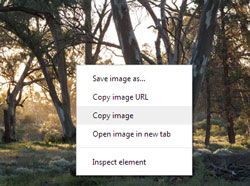The Australian Law Reform Commission has recommended an approach to the copyright of online photos which is a severe threat to the livelihood of pro photographers, and also brings into question copyright protection for both amateurs and professionals.
The recommendations to free up copyright law is contained in a 388-page discussion paper called ‘Copyright and the Digital Economy’, which was made public at the end of May.
Following from an article published on Photo Counter a new UK law on ‘orphaned works’, it emerges that the ALRC is favouring a similar approach here, where if an ill-defined ‘reasonably diligent search’ is carried out to discover the owner of the copyright to a photo and it fails, usage is allowed.
This will probably entail some kind of collection agency which will be paid a fee to conduct a diligent search and administer the system. However, there is no definition of what a diligent search might look like. In the case of internet photos, could it be as basic as an image search?
Orphaned works are things like out-of-print books, archival film and video – and photographs. While most orphaned works are old, a digital photo can become an orphaned work hours after its created. And images in old magazines or books are more likely to become orphaned than other works.
While notions of fair usage and diligent searches may protect the rights of owners to other kinds of orphaned works, photos, particularly photos on the internet, are a singular case. The thing which distinguishes digital photos – besides the sheer needle-in-a-haystack number of them – is that they are so easily kidnapped, as opposed to orphaned. But unless there’s a considered and convincing response from professional photographers groups, the new proposals are likely to become law.
The ALRC report even acknowledges photos are going to be tricky: ‘The ALRC heard that photographs are susceptible to being orphaned due to rights information being removed when placed online.’
– However there are no remedies suggested, so unless the photo industry speaks up for itself it is likely to be collateral damage in the otherwise worthy effort to liberalise copyright on older works and free up creative content.
The current law says that there is no ‘orphaned works’ exception to copyright. If you are not the owner of the copyright to an image, you simply can’t use it until it falls into the public domain at the end of the copyright term. Copyright protection is a given.
For instance, this month US photographer Robert Caplin is suing celebrity muck-raker Perez Hilton for copyright infringement after he used photos of Glee actor Darren Criss on his site without permission, according to a complaint filed in Los Angeles Federal Court.
Mr. Hilton published 14 copyrighted images on PerezHilton.com and added his own watermark over the photographer’s. Mr Caplin is asking for damages of $2,100,000 ($150,000 per photograph).
One wonders how Mr Hilton could assume he was going to get away with it, given the high profile of all involved, but for every newsworthy incident like this there must be hundreds or even thousands of transgressions where the copyright owner remains in blissful ignorance. (But in this case, what they don’t know does hurt them.)
Many if not most photos on the internet don’t carry any copyright information.
Sometimes it is stripped out when it is posted on social network sites, sometimes the ownership is not lodged in the metadata, sometimes the copyright data is simply cropped off. But publishers, ad agencies, etc, all understand that using someone else’s photos without permission, without the right to make a copy – is illegal. That fundamental protection will be removed with these proposed changes, so that using someone else’s photos just might be illegal.
These are the ALRC’s proposals on Orphan Works:
Proposal 12–1: The fair use exception should be applied when determining whether a use of an ‘orphan work’ infringes copyright.(‘Fair use’ is another can of worms for photographers, but beyond the scope of this article. Suffice it to say that it may be fair use for the user, but not necessarily for the creator.)
Proposal 12–2: The Copyright Act should be amended to limit the remedies available in an action for infringement of copyright, where it is established that, at the time of the infringement:
(a) a ‘reasonably diligent search’ for the rights holder had been conducted and the rights holder had not been found; and
(b) as far as reasonably possible, the work was clearly attributed to the author.
Proposal 12–3: The Copyright Act should provide that, in determining whether a ‘reasonably diligent search’ was conducted, regard may be had, among other things, to:
(a) how and by whom the search was conducted;
(b) the search technologies, databases and registers available at the time; and
(c) any guidelines or industry practices about conducting diligent searches available at the time.
(- Say what!?)
The ALRC Inquiry into copyright is reaching its final stages. Following publication of the Copyright and the Digital Economy Discussion paper, the ALRC is calling for submissions, with a final report to go to the Attorney-General by November 30. The cut-off date for submissions is July 31.
The AIPP is aware of the looming deadlines, according to executive director, Peter Myers, and AIPP member and long-time champion of photographers rights, Chris Shain is working on a submission on the Institute’s behalf. Moreover, the AIPP will be mobilising pro photographers via its emailed newsletter to agitate around the proposed changes.
To access the ALRC discussion paper in a range of digital formats (which also contains directions on how to make a submission) click here.


